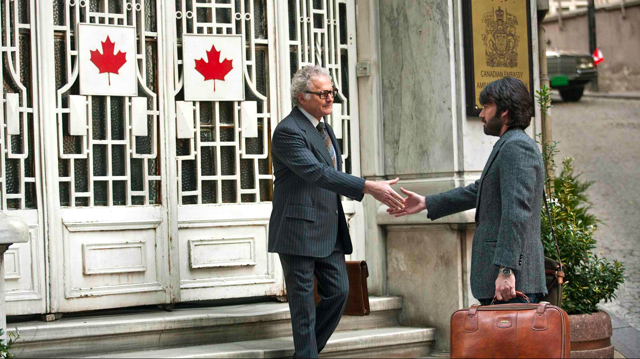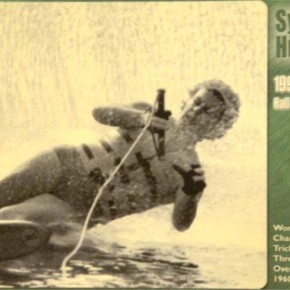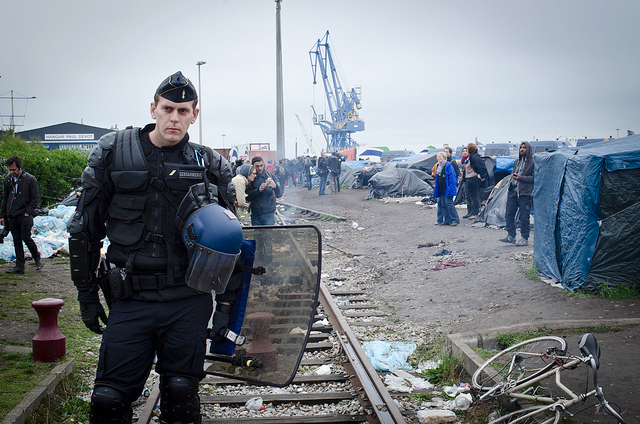Pornography isn’t the only cinematic genre with a “money shot.” Historical reenactments like Ben Affleck’s new picture Argo are also keen to demonstrate their authenticity. Except that the proof comes, not in a milky stream of ejaculation, but in the details of a mise-en-scène painstakingly recreated from documentary evidence.
Sometimes a sense of accuracy is conjured purely from details likely to inspire self-aware recognition in the audience, such as hairstyles, clothing, automobiles etc. But a film that depends heavily on the caché of being a “true story” will often supplement its production design with media from the period being depicted.
Argo is a perfect example. Not only does the film regularly show characters watching actual television broadcasts about the American embassy hostage crisis from 1979 and 1980 — most notably ABC’s Ted Koppel on the late-night news program that would develop into Nightline — it also uses the end credits to juxtapose stills of its actors with photographs of the real people they play. The care the filmmakers have taken to get things right is plain to see.
That’s the problem with Argo. Like most mainstream Hollywood fare, it wants desperately to be liked. But it also insists on being liked for its likeness, despite the fact that the story it painstakingly tells is one of supreme fakery. Given the film’s subject matter, American relations with Iran, and its release date, shortly before the 2012 Presidential election, this contradiction is burdened with great significance.
As the advance promotional materials for Argo made sure to emphasize, the film relates the tale of a clandestine CIA operation to retrieve six Americans who managed to escape the United States’ embassy in Tehran just prior to its takeover and the hostage crisis that resulted. When those six Americans initially made it out of Iran, their rescue was credited to the Canadians, whose Ambassador had hidden them away until safe passage could be arranged.
Argo acknowledges the bravery of this diplomat and his wife to a degree, but explains that, while they harbored the six Americans at great personal risk, it was actually an American agent, Tony Mendez, who engineered their escape and in a most improbable manner: pretending to make a movie. This is where Ben Affleck’s film gets its title, from the fake production that the CIA set up with the help of some Hollywood B-movie veterans.
The fake Argo was billed as one of the many Star Wars rip-offs being undertaken in the late-1970s, only with Canadians at the helm who, in a strange quest for authenticity, had decided that Iran might be a good place to shoot its moments of science-fiction Orientalism. Considering the tumult that the country was experiencing in the wake of the Shah’s overthrow, this might seem like a preposterous notion.
But the genius of the CIA plan is that it took full advantage of Hollywood’s reputation for excess and absurdity. This was the same period, after all, in which films like Francis Ford Coppola’s Apocalypse Now and Michael Cimino’s Heaven’s Gate became legendary examples of directorial megalomania while they were still in production; when the drug-fueled irrationality of major and minor players in the industry was common knowledge from Cahuenga to Cannes; and when new technology had made it possible even for low-budget pictures to be shot on location, in part because special effects could be farmed out to contractors who did not need the rest of a film’s crew to do their work.
While none of this is explicitly stated in Argo, the often hilarious scenes involving the fake film’s Hollywood champions, played by Alan Arkin and John Goodman, do an able job of evoking the era. Less clear is why otherwise stalwart revolutionaries would be susceptible to such a scheme. Why would the new Iranian regime, so intent on demonstrating its ideological purity, be willing to facilitate, the production of a cheesy Star Wars rip-off, replete with scantily clad women?
To the credit of Argo’s creators, we are at least given some hints. At one point, reference is made to the fact that many Iranians have relatives in the Los Angeles area, “selling prayer rugs and eight tracks on La Brea.” Although offensively presented — albeit in character — this is a useful reminder why interest in Hollywood goings-on might have been greater in Tehran than in most places around the world.
We also see Ben Affleck’s CIA agent, upon his arrival in Tehran, sitting down with an Iranian government official who laments that most of the city’s cinemas were screening pornography prior to the revolution. It is unclear whether he means what would meet the Western definition of this term or, rather, the far more capacious usage of Islamic fundamentalists. Either way, though, the idea is clearly established that there is an audience in Iran for films that don’t pass revolutionary muster.
What Argo fails to indicate is the unique role that film played in the Iranian revolution, both as a prime target of the critique of secularism and, more specifically, through the 1978 fire at the Cinema Rex in Abadan, which killed over four hundred people. Blamed, by turns, on both the Shah’s hated security forces and fundamentalist radicals, the fire ushered in a dark age of Iranian cinema but one which, like the suppression of theater in seventeenth-century Puritan England, failed to stamp out passion for the medium and may, in fact, have ended up making it stronger. In other words, by the time that the CIA rescue mission got underway in early 1980, it could be argued that there was considerable pent-up demand among Iranians who had grown up with the movies.
This would be consistent with Argo’s underlying message. Several times in the film, we see Western officials watching coverage of the hostage crisis with a skeptical eye, as though it were suspiciously like a “made-for-television” event. On one occasion this conclusion is spelled out explicitly, with a note of betrayal, as if there were something unfair about fundamentalists getting to have their revolution and make a spectacle of it as well. We get the sense that this outwardly mad CIA plan will succeed precisely because it is rooted in the conviction that a society deprived of movies will be driven to madness.
Argo falls squarely into a long tradition of Hollywood-to-the-rescue tales. But its self-congratulatory air puts most of its predecessors to shame. Not only does the film industry save the day in 1980 by providing the perfect cover story for the CIA mission. It also tries to save the day in 2012 by reminding audiences why the Iranians got mad at the United States in the first place, and what it might take to win back their hearts and minds: the film industry.
To be fair, this circular logic mirrors some of the most influential Iranian films of the past few decades. The self-reflexive genius of directors like Abbas Kiarostami and Jafar Panahi is founded on the belief that the illusions perpetrated by cinema can be turned inside out to reveal truths that could otherwise not be expressed. For them, this creative approach is born of necessity, the only way they can make meaningful art in a climate of censorship and the ever-present specter of more severe political oppression. Films that are about their own conditions of possibility are, in a sense, the only truthful films it is possible to make.
But what are we to make of Argo’s underlying message, that, when faced with a seemingly impossible situation, film has the potential to set us free? By going out of its way to insist on its authority, even to the point of having Jimmy Carter provide his Presidential seal of approval over the credits, Argo might appear to be consigning fiction to a subordinate role in real-world affairs. Yet the fact that this apparent commitment to truthfulness is deployed to document a charade and, what is more, a fundamentally cinematic one, suggests that taking this superficially earnest film at face value would be a mistake.
We can admire Argo for revisiting the hostage crisis at a time when war with Iran becomes more likely with each passing day, as Barack Obama and Mitt Romney try to outdo each other with hard-line rhetoric. We can marvel that the film tells a “true story” in which great effort was expended to get the details as close to the historical record as possible. But we must not be lulled into thinking that we are watching the mere presentation of facts. Because if the original Argo could fake its intended audience out, so can this one.
In this regard, it’s important to take a few step backs from Argo‘s narrative to ask what motivations such noted Hollywood liberals as Affleck, Arkin and co-producer George Clooney might have for wanting to bring it to light. Yes, it makes Hollywood look good — a goal that everyone in the industry from Matt Damon to Clint Eastwood can surely agree on — but in the process of making the CIA look pretty good as well.
While the film’s somewhat erroneous summary of the history leading up the Iranian revolution does acknowledge the American role in the coup d’etat that drove Prime Minister Mohammed Mossadegh from power in 1953, its overall effect is to make us root for people whom it’s not easy to root for. If we take Argo‘s release date into account, it’s easy to wonder whether its ideological purpose might be to shore up President Obama’s hawkish bona fides in a campaign where the question of what to do with and to Iran looms large.
As moviegoers think back on the experience of Argo, they would do well to remember that this film that gets so many fine points of mise-en-scène right also asks us to take a sweeping panorama of the San Gabriel Mountains, seen in an aerial shot taken from the south, as an acceptable stand-in for the Alborz Mountains north of Tehran.
It’s a beautiful moment in a story that is otherwise dominated by the claustrophobia of tight spaces. But there’s a reason why it’s necessary that we must not forget. Because even though the CIA was able to trick the Iranian government into giving permission to shoot the first Argo on location, there was no way in hell that it was going to be granted this time around. The Los Angeles Basin may have a lot in common with its equivalent in Tehran, from smog to a large Farsi-speaking population, but it is every bit as much a part of the United States as Washington D.C., no matter how much energy Hollywood expends to convince us — and audiences around the world — otherwise.
Screenshot courtesy of Warner Bros. Entertainment. All rights reserved.





